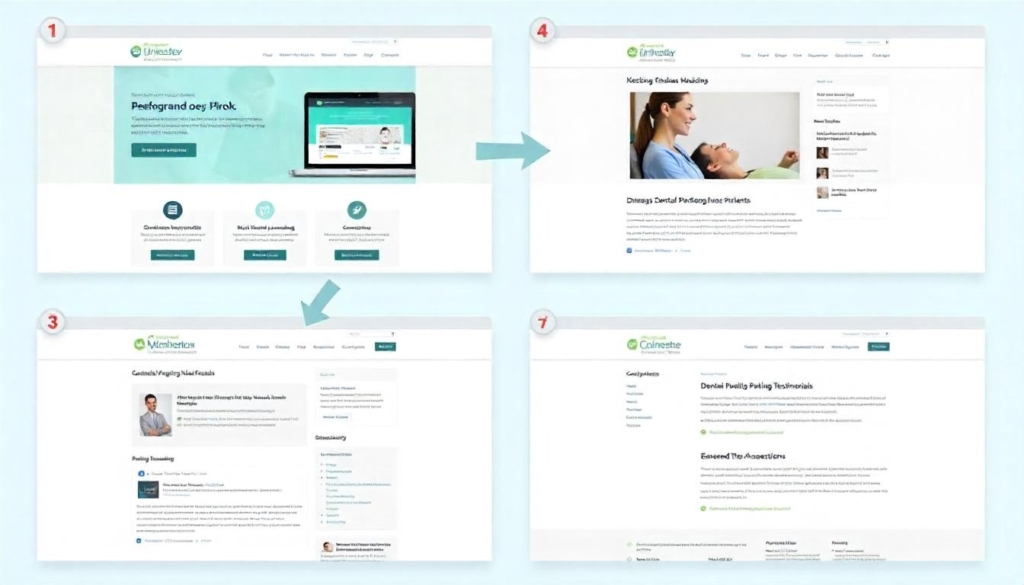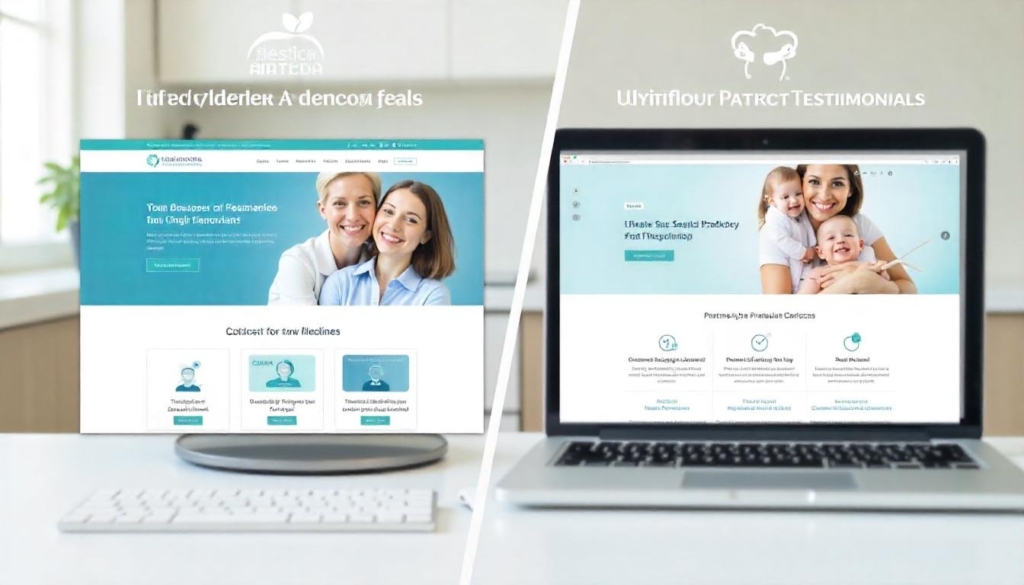What Content You Need & How to Structure It for Your Dental Website
Building a successful dental website isn’t just about a sleek design and engaging visuals it’s also about providing valuable, informative content that resonates with your audience. A well-structured dental website will not only improve the user experience but also drive higher engagement, boost your search engine rankings, and establish trust with potential patients.
For dental practices, content is a key component in turning website visitors into loyal patients. Your website should contain a mix of well-organized, keyword-optimized pages designed to guide patients to take action, whether that’s scheduling an appointment, learning about a specific procedure, or simply exploring your practice’s offerings.
Let’s dive into the content you need for your dental website and how to structure it to maximize its effectiveness.

Related Posts
- Best Dental Website Design Examples 2025
- Must-Have Elements That Convert Visitors to Patients
- What to Look for in a Dental-Specific Web Designer
Content Strategy for Dental Website Pages
Homepage – First Impressions Matter
The homepage of your dental website is like the front door to your practice. It’s where patients form their first impression of you. The goal here is to provide a clear, engaging snapshot of your practice’s offerings, personality, and trustworthiness.
Expert Insight: Your homepage should be simple but informative. Use concise copy that communicates who you are, what services you offer, and how patients can benefit from choosing your practice. Avoid overwhelming visitors with too much information focus on what matters most.
Key elements to include:
- Introduction to your practice: A brief welcome message that highlights your practice’s values and commitment to patient care.
- CTAs (Calls to Action): Encourage visitors to take action immediately. Common CTAs include “Book an Appointment” or “Contact Us Today.”
- Service Highlights: Briefly mention your most popular services with links to more detailed service pages.
- Trust signals: Include testimonials, awards, or certifications to build credibility.
Service Pages – Clear, Detailed, and Patient-Centered
Service pages are critical in showing potential patients that you can meet their needs. These pages should focus on the specific dental treatments you offer, answering key questions patients may have while addressing their pain points.
Expert Insight: To make your service pages effective, create content that speaks directly to your patients’ concerns and needs. Each service page should be educational and should incorporate keywords relevant to the service being discussed. Remember to be empathetic and clear in your language, as many patients will be anxious or unsure about certain treatments.
Key elements to include:
- Patient pain points: Address common concerns or fears patients may have related to the service.
- Treatment benefits: Focus on how the service can help improve the patient’s life or solve their specific dental issue.
- Step-by-step descriptions: Help patients understand what to expect during the treatment process, from consultation to post-care.
- Internal linking: Link to other related services or educational resources to keep patients engaged on your website.
Blog – Engaging Content for SEO and Education
A dental blog is an excellent way to engage your audience, educate patients, and boost your website’s SEO. Regularly updated blog posts allow you to address common questions, share dental tips, or discuss the latest trends in the dental industry. Blogs can also target specific keywords and create opportunities for internal linking.
Expert Insight: Use your blog to establish your practice as an authority in the dental field. Writing about relevant topics that answer patient questions not only positions you as an expert but also helps improve your search engine rankings. Be sure to incorporate targeted keywords into your blog posts, but always focus on providing valuable content first.
Key blog topics:
- Dental tips and tricks: Practical advice that helps patients take better care of their teeth.
- In-depth procedure explanations: Educate patients on dental procedures they may be interested in or need.
- Latest news and innovations: Share updates on advancements in dental technology or treatment options.
- Patient testimonials and success stories: Feature real patient stories that showcase the results your practice delivers.
About Page – Building Trust with Potential Patients
The “About” page is where you can build a deeper connection with your visitors. Patients are not just looking for dental services, they are looking for a practice they can trust. Your “About” page should tell your practice’s story, highlight the team’s experience, and showcase the unique aspects of your care.
Expert Insight: People trust people, so your “About” page should focus on the people behind the practice. Share the background and credentials of your dental team, your practice’s mission, and what sets your practice apart from others.
Key elements to include:
- Your story: Briefly tell the story of how your practice started and what makes it unique.
- Meet the team: Include photos and bios of your dental professionals, highlighting their expertise and passion for patient care.
- Your values: Explain what your practice values, such as patient care, education, and creating a comfortable environment.
Testimonials – Establishing Credibility and Trust
Patient testimonials are one of the most effective ways to build trust and credibility with new visitors. Positive reviews from satisfied patients can provide social proof that your dental practice delivers on its promises.
Expert Insight: Ask your satisfied patients for feedback and showcase these testimonials on your website. Video testimonials can be especially powerful, as they add a personal touch and help visitors connect with your practice on a deeper level.
Key places to feature testimonials:
- Homepage: Feature a rotating selection of patient testimonials to capture attention right away.
- Service pages: Add testimonials specific to the services you provide to show real-world results.
- Dedicated testimonial page: Consider having a full page dedicated to patient stories and success stories.
Related Posts
- Turn Visitors into Booked Appointments
- Back-End Essentials for Reliability, Compliance, and Trust
- Adapting Design to Specific Practice Types
FAQs – Answering Common Patient Questions
Patients often have questions that aren’t fully addressed on service pages or in initial consultations. Your FAQ page is an opportunity to answer these questions and provide clarity before they even step foot in your office.
Expert Insight: A well-structured FAQ page can save you time by answering common patient inquiries in one place. It also builds trust by showing that you’re transparent and proactive in addressing patient concerns.
Key topics to include:
- Insurance and payment options: Explain what insurance plans you accept, payment options, and financing.
- What to expect during visits: Answer questions about what patients can expect during their first visit or a specific treatment.
- Post-treatment care: Provide detailed instructions on what patients should do after a procedure to ensure proper healing.

Structuring Your Dental Website Content for Maximum Impact
Keyword Optimization and Content Structure
To ensure your dental website ranks well in search engines, it’s important to structure your content with SEO in mind. Each page of your website should include optimized headings, relevant keywords, and clear calls to action.
Expert Insight: Use keyword-optimized headings (H2, H3) that clearly describe the content on each page. This makes your content more scannable for readers and improves your website’s SEO. It also helps search engines understand what the page is about and rank it higher in relevant search queries.
Key SEO Strategies:
- Internal Linking: Link related content within your website to keep patients engaged and improve your SEO rankings.
- Local SEO: If you’re a local dental practice, incorporate location-based keywords (like “dentist in [City Name]”) into your content to attract patients from your area.
- Use of Meta Descriptions: Craft concise, compelling meta descriptions for each page that include relevant keywords.
Content for Different Patient Personas
Every dental website should cater to the different needs of its potential patients. Your website will attract new patients, those seeking specific dental services, and current patients who are returning for appointments. Understanding your audience and structuring your content accordingly will help increase conversion rates.
Expert Insight: Tailor your content to address the different pain points, needs, and questions of each patient persona. For example, new patients may be interested in “What to Expect During Your First Visit,” while existing patients may look for detailed information on specific treatments or post-care instructions.
Building a Well-Structured Dental Website
The content you use on your dental website is just as important as the design. By focusing on the essential pages: homepage, service pages, blog, testimonials, about page, and FAQs, you create a well-rounded and functional site that addresses both patient needs and SEO requirements. Structure your content with clear, keyword-optimized headings, and ensure you are addressing patient pain points to foster trust and engagement.
Key Takeaways:
- Focus on key pages: Homepage, service pages, blog, about, testimonials, and FAQs.
- Optimize content for SEO: Use keyword-optimized headings, local SEO, and internal linking.
- Address patient concerns: Tailor your content to your patients’ needs and ensure it’s educational, clear, and empathetic.
FAQs:
What content should my dental website include?
Your dental website should include key pages like a homepage, service pages, a blog, about, testimonials, and an FAQ page to address patient needs and improve SEO.
How can I make my dental website SEO-friendly?
Use keyword-optimized headings, include relevant keywords, link to other pages on your site, and ensure your content is structured clearly and logically.
Why are testimonials important on a dental website?
Patient testimonials build trust and credibility by showing prospective patients real experiences from others, helping them make informed decisions.
How often should I update my dental website’s content?
Regularly update your blog with fresh, informative content, and update service pages as necessary to reflect any changes in services or team members.
